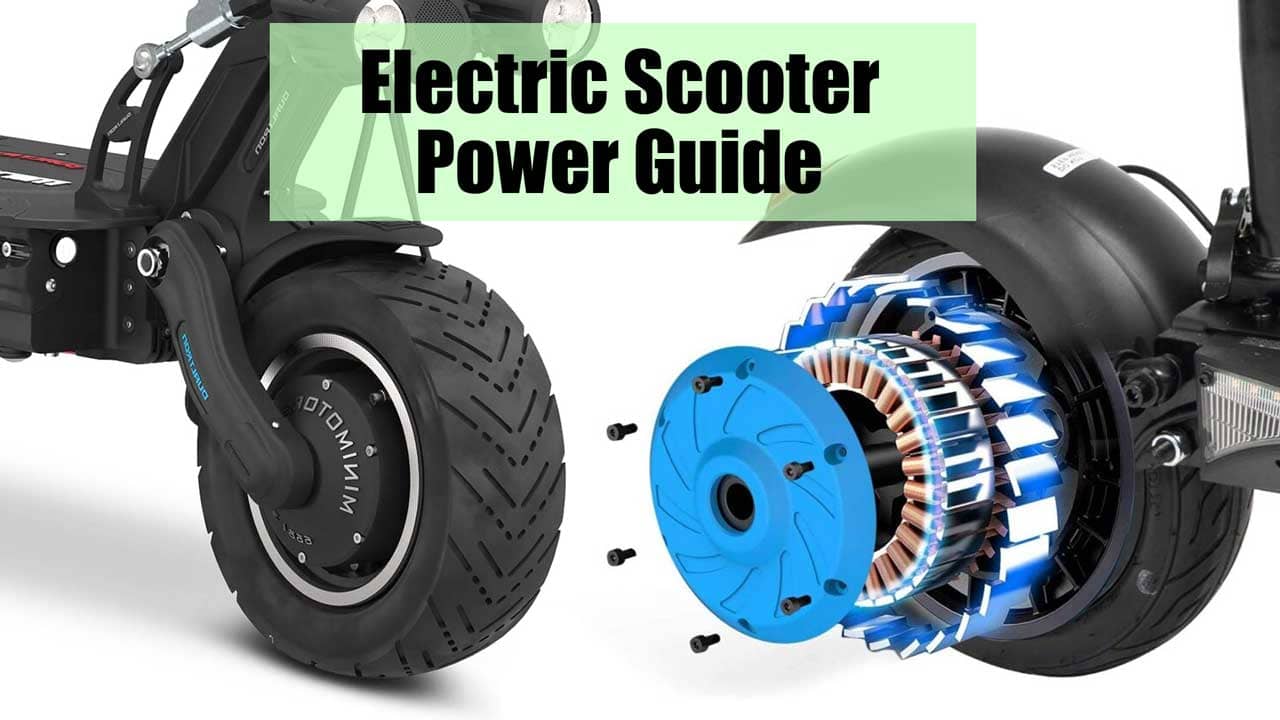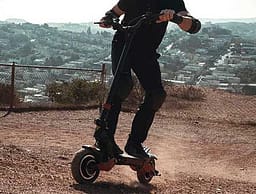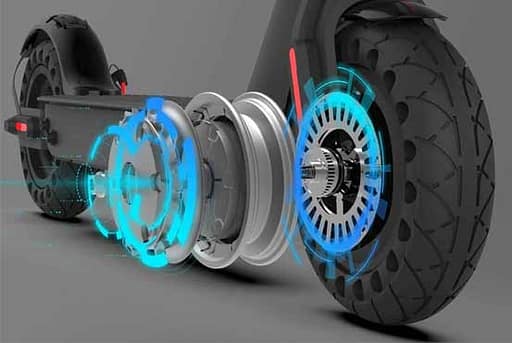
A crucial aspect to consider when purchasing an electric scooter is determining the appropriate power requirements for your specific needs. In this article, I will delve into not only how it works, but also the factors that influence the power needs of electric scooters.
With the aim of helping you in choosing an electric scooter that meets your commuting requirements, we provide guidance to ensure that you select a model with adequate power capacity.
Understanding the Power of Electric Scooters
Electric scooters are available with various powerful motors, which determine their performance capabilities. The most common models have just one motor while some of the more heavy-duty units come with twin motors.
Power refers to the amount of electrical energy the scooter’s motor can generate to propel it forward. Power is typically measured in watts or horsepower. A higher power rating indicates a more powerful motor and the ability to handle challenging terrains and propel you forward at higher speeds.
How to calculate the power
Power can be calculated by considering factors such as voltage and current. The voltage represents the electrical potential, while the current measures the flow of electricity. Together, they determine the power output of the scooter’s motor/s, influencing its performance and the overall ride experience.
Importance of choosing the right power
Selecting the appropriate power rating is vital as it directly affects the scooter’s performance and capabilities. Insufficient power may result in sluggish performance, while excessive power may in some cases lead to a lackluster user experience.
More power also equals heavier weight and an overall more bulky ride. With those things in mind, you will want to choose a scooter that works best for your needs.
If you´re looking for a scooter that walks the line of balance perfectly I’d suggest having a look at our Ninebot Max G2 review.
Factors influencing power
Several factors influence the power requirements you will have on your electric scooter. These factors include the weight and size of the scooter and its user, speed limits/need, and how much acceleration you want to have at your disposal.
Additional important factors to take into consideration are terrain and incline, average distance per charge, and any features or accessories that might consume additional power.

Common scooter models performance comparison
| Scooter Model | Peak Motor Power (W) | Battery Size (Wh) | Top Speed (mph / km/h) | Range (miles / km) |
|---|---|---|---|---|
| Dualtron Victor | 4000 | 2072 | 52 mph / 84 km/h | 75 miles / 120 km |
| Apollo Ghost | 1600 | 1248 | 34 mph / 55 km/h | 37 miles / 60 km |
| Ninebot Max | 900 | 1536 | 15.5 mph / 25 km/h | 28 miles / 45 km |
| Xiaomi 4 Pro | 600 | 768 | 18.6 mph / 30 km/h | 28 miles / 45 km |
Calculating the Power Needs of Your Electric Scooter
To determine the power needs of your electric scooter accurately, it is crucial to consider various factors that affect its performance. By evaluating these factors, you can make an informed decision about how powerful of a scooter you need to best fit your requirements.

Total weight while riding
The total load of the scooter while operating plays a significant role in determining its power needs. Heavier loads generally require more power to propel and maintain higher speeds effectively.
Determining the maximum speed and acceleration
If you intend to use the scooter for longer commutes you should opt for a higher power rating to be able to cover more ground faster. These scooters often also carry a larger battery which gives you greater range per charge.
For shorter commutes, such as inner-city rides, riders can experience heightened enjoyment by opting for a lighter, less powerful scooter.
Considering the terrain and incline factors
The type of terrain you will be riding your electric scooter on is another crucial aspect to consider. Rough terrains, steep hills, or frequent inclines may demand more power to maintain a consistent speed and ensure a smooth riding experience.
Estimating the average distance per charge
The average distance you intend to cover on a single charge is also of importance when determining your power needs. Higher-power scooters come equipped with larger batteries that can provide extended range, enabling you to travel further without the need for frequent recharges.
Selecting the Appropriate Power Rating for Your Electric Scooter
Once you have evaluated the various factors that influence power requirements, it is time to choose an electric scooter with enough power to provide you with the best possible riding experience. This section provides guidance on matching the power rating to your specific usage requirements while considering important trade-offs.
Understanding the power rating and its significance
The power rating of an electric scooter is typically measured in watts or horsepower. It represents the amount of electrical power the motor can generate to propel the scooter. Higher power ratings indicate greater performance capabilities but may have trade-offs like weight and size.
Matching the power rating to your usage requirements
Consider your typical usage scenarios and determine if you will need higher speed and more power, or if it would be sufficient with a smaller simpler model. If you primarily use your scooter for short commutes in urban areas, a moderate power rating would suffice. However, if you require higher speeds or plan to ride on challenging terrains, or if your area has a lot of inclines, opting for a more powerful model may be necessary.
Considering the trade-off between power and weight
It is essential to strike a balance between power and weight when selecting an electric scooter. Higher-powered scooters like the TurboWheel models tend to come with a larger battery and a more sturdy structure, adding extra weight. Assess your priorities and find the optimal compromise between power and bulkiness.
Speed per Watt
The relationship between power and speed is not linear. Initially, as the power increases, the speed gain per watt tends to be more significant. However, as the power rating continues to increase, the speed gains become less pronounced. This is due to various factors like aerodynamic limitations, rolling resistance, and other design constraints.
It’s worth noting that speed is influenced by multiple factors besides power alone, such as the scooter’s weight, battery capacity, controller settings, and terrain conditions. Additionally, scooter manufacturers may prioritize other features, such as battery life or torque, which can affect the speed-to-power ratio.
Therefore I cannot provide any specifics on an average top speed for a scooter with x W motor. Luckily for you, we here on Aridejunkie do hands-on testing on all the scooters we review and can provide you with an extensive list of real-life top speeds for a large selection of the most popular electric scooter models.
Tips for Optimal Power Management
To make the most of your electric scooter’s power, there are several tips and techniques you can follow to manage and conserve power effectively.
Proper maintenance and care for the battery
Regular maintenance of your scooter’s battery, such as keeping it clean, ensuring proper connections, and avoiding extreme temperature conditions, can significantly enhance its performance and power efficiency.
Efficient riding techniques to conserve power
Adopting efficient riding techniques, such as maintaining a steady speed, avoiding abrupt accelerations and decelerations, and utilizing the regenerative braking system most scooter models have, can help conserve power and extend the range of your ride.
Avoiding unnecessary weight and drag on the scooter
Reducing unnecessary weight and drag on your electric scooter can improve its power efficiency. Removing any unnecessary accessories or cargo and ensuring proper tire pressure can contribute to a smoother and more energy-efficient ride.
Charging habits and guidelines for battery longevity
Adhering to proper charging habits and guidelines, such as using the recommended charger, avoiding overcharging or deep discharging the battery, and following manufacturer instructions, can extend the overall lifespan of your scooter’s battery.
We have a comprehensive guide on how to properly take care of your electric vehicle’s battery that you can read here.
Conclusion
Selecting the appropriate power rating for your electric scooter is crucial to ensure optimal performance and a satisfying riding experience. After reading through most of this guide you should have an adequate understanding of how to evaluate your scooter’s power needs. Remember to balance power with usability and adopt the efficient power management practices explained above to maximize the longevity of your ride.
FAQs
How can I determine the power rating needed for my electric scooter?
To determine the power rating, evaluate factors such as weight, size, desired speed, terrain, and distance per charge. Consider your specific usage requirements and strike a balance between portability and power.
What happens if I choose a power rating that is too low for my needs?
Opting for a scooter that has inadequate power for your needs may result in sluggish performance, longer travel times, and an inability to handle inclines or challenging terrains effectively.
Can I upgrade the power rating of my electric scooter later on?
In most cases, the motors of an electric scooter are not straight-up upgradeable. It can often be done, but the cost and work involved is a lot. Therefore it is important to choose a scooter with enough power to fulfill your needs during the initial purchase.
Is it better to have a higher-watt motor for faster speeds?
A more powerful motor contributes to faster speeds, it also adds more power to handle inclines and rough terrain.
How can I extend the battery life of my electric scooter?
To extend the battery life you need to maintain good charging habits, adopt efficient riding techniques, and ensure regular maintenance and care of the battery.







